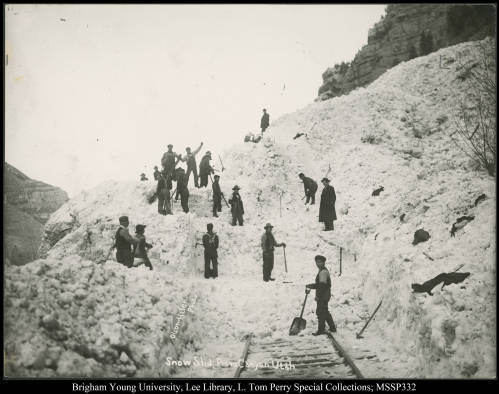Dublin Core
Title
Description
On the morning of February 19th 1897, Will Slick woke up to total silence. It was quiet… it was too quiet. Normally, he would hear the rushing waters of the Provo River from his window at the Telluride School of Electrical Engineering at the mouth of Provo Canyon. But not today. The river was silent and the cold, still morning rang alarm bells for Slick.
He was worried about his neighbor, Billy Ferguson, a colorful character who lived further up the canyon. Travelers often stopped at Ferguson’s homestead to rest, water horses, or eat a meal as they made their way through the canyon. That winter morning, Slick rode out with several other Telluride students to investigate, only to discover that a devastating avalanche had swept down the canyon the previous night. The slide came from the south slope of the mountain, pushed through the narrow gorge, and blocked the river. It also overwhelmed Billy Ferguson’s house and property. The force of the snow lifted his house off its foundation, carried it for some distance, and buried its human occupant under a thick layer of snow and ice. At its deepest, the avalanche’s snow measured nearly fifty feet, but just a short distance from Ferguson’s house the snow measured a mere two feet.
Sadly, the scene was not uncommon. Avalanches were a part of winter life for Utahns living near the mountains. Snowslides regularly tore through Utah’s canyons, taking lives and crushing infrastructure. Years of similar destruction in other canyons of the Wasatch Mountains finally motivated the US Forest Service to appoint its first Snow Ranger in 1939, which was part of a program devoted to the study of avalanche science.
Today, much more is known about avalanche forecasting, safety, and prevention in Utah’s canyons. We now live, work, and recreate in slide-prone areas thanks to mitigation techniques that better control destructive avalanches. Unfortunately for Billy Ferguson and the community who loved him, that snowy night in Provo Canyon ended in tragedy – and a grim reminder of the unpredictable wrath of nature’s storms.
Creator
Source
_______________
See Robert Carter, “A Fatal Snowslide in Provo Canyon,” Utah History Blazer (December 1995);“A Storm of Snow Slides,” Salt Lake Herald-Republican, February 20, 1897; “Dead in a Snowslide,” Salt Lake Tribune, February 20, 1897; “Dead in a Snowslide,” Salt Lake Tribune, February 20, 1897; “Another Slide,” Provo Daily Enquirer, February 19, 1897; “Avalanches have a Deep History in Provo Canyon,” Provo Daily Herald, March 10, 1996; Utah Department of Public Safety, Utah Hazard Mitigation, “Avalanche”; “History of Avalanche Forecasting and Mitigation in Utah,” Ski Utah, November 16, 2020; Quinn Graves, “A History of Avalanche Mitigation in the Cottonwood Canyons,” Central Wasatch Commission, accessed 11/23/2021.

